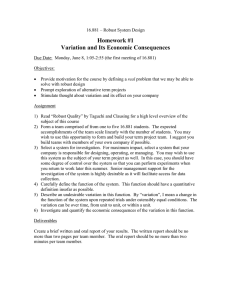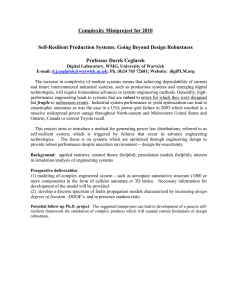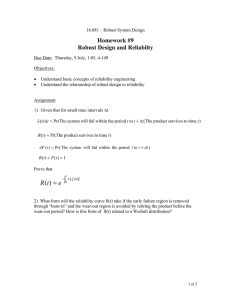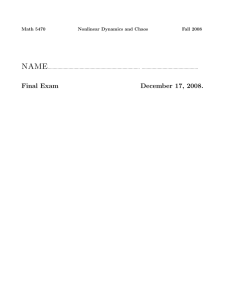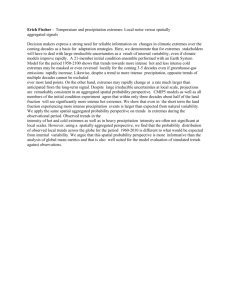Robust Extremes in Chaotic Deterministic Systems
advertisement
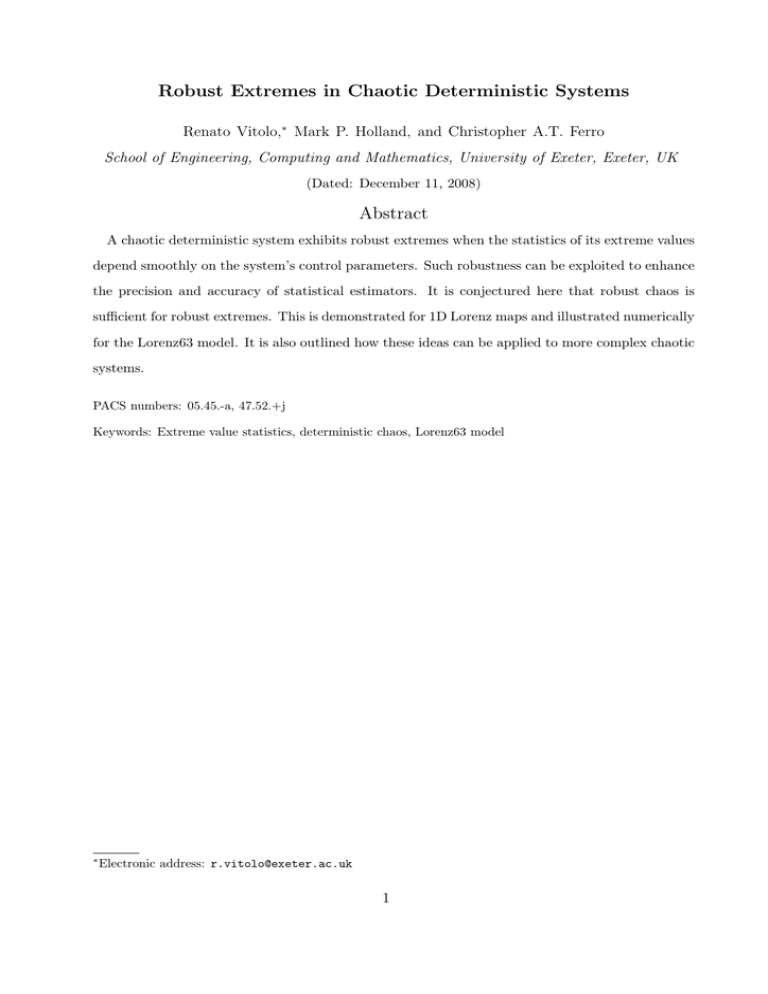
Robust Extremes in Chaotic Deterministic Systems
Renato Vitolo,∗ Mark P. Holland, and Christopher A.T. Ferro
School of Engineering, Computing and Mathematics, University of Exeter, Exeter, UK
(Dated: December 11, 2008)
Abstract
A chaotic deterministic system exhibits robust extremes when the statistics of its extreme values
depend smoothly on the system’s control parameters. Such robustness can be exploited to enhance
the precision and accuracy of statistical estimators. It is conjectured here that robust chaos is
sufficient for robust extremes. This is demonstrated for 1D Lorenz maps and illustrated numerically
for the Lorenz63 model. It is also outlined how these ideas can be applied to more complex chaotic
systems.
PACS numbers: 05.45.-a, 47.52.+j
Keywords: Extreme value statistics, deterministic chaos, Lorenz63 model
∗
Electronic address: r.vitolo@exeter.ac.uk
1
We consider how extreme values in chaotic deterministic systems respond to changes in
the system’s parameters. Extreme values can be associated with disruptive or catastrophic
events (in the climate system or in financial markets for example) and so their behaviour
is of both scientific and societal interest. Extreme-value theory (EVT) provides models for
extremes in stationary stochastic processes and progress has been made recently in extending
EVT to chaotic deterministic systems [1–5]. Understanding the response of deterministic
systems to variation of control parameters leads to the study of bifurcations [6], typically
associated with dramatic changes in behaviour [7]. Chaotic systems, however, often respond
regularly to parameter variation. This phenomenon is called robust chaos [8] and is found in
several systems, from neural networks [9] to (piecewise) smooth maps [10, 11]; see [12] and
references therein. In this note we take initial steps towards understanding robust extremes,
where the statistics of a system’s extreme values vary smoothly with its parameters. We
conjecture that robust chaos is sufficient for robust extremes and demonstrate that this is
the case for 1D Lorenz maps.
Robust extremes were discovered recently in the 192-dimensional ordinary differential
equation of [13]. This is a model for the atmospheric circulation at mid-latitudes in the
Northern Hemisphere, providing a simplified representation of key physical processes (baroclinic conversion, barotropic stabilisation, thermal diffusion and viscous-like dissipation).
The model has a robust chaotic attractor for suitable values of a parameter TE representing
baroclinic forcing [14]. The extremes of the system’s total energy have a smooth power law
in TE .
The following numerical study illustrates the robustness of extremes for the Lorenz63
model [15]:
ẋ = σ(y − x),
ẏ = x(ρ − z) − y,
(1)
ż = xy − βz,
derived from the Rayleigh equations for convection in a fluid layer between two plates.
Here σ is the Prandtl and ρ the Rayleigh number; see [16] for a dynamical study. For the
“classical” values σ = 10, β = 8/3 and ρ = 28, (1) has a strange attractor [17], which is
robust in the sense of [18]. This definition is different from that of [8] although the practical
implications are similar.
2
For each ρj = 27 + 0.05j (j = 0, 1, . . . , 20), time series of length 10n units are generated
from (1) for n = 5, 8. The time series consist of values of x, proportional to the intensity of
the convective motion [15], recorded every 0.5 time units along an orbit [39]. Maxima from
blocks of 1000 time units are extracted from each series [40] and their frequency distributions
are modelled with the generalised extreme value (GEV) distribution function
" −1/ξ #
x−µ
G(x; µ, σ, ξ) = exp − 1 + ξ
,
σ
+
(2)
where σ > 0, ξ 6= 0 and w+ = max{w, 0}. The GEV model is justified by EVT and its
parameters (µ, σ, ξ) are estimated by maximum likelihood [19, 20].
The GEV parameter estimates converge to smooth functions of ρ for large n (Fig. 1 (a)(c)) but estimates of ξ for n = 5 oscillate wildly around the “truth” obtained with n = 8.
Accurate estimation of the tail index ξ is essential for extrapolating return levels to return
periods which are larger than the record length [20]. Climatic records seldom contain more
than 100 annual maxima [13], so fast convergence of estimators is desirable.
Robustness of extremes can be used to enhance the accuracy and precision of the GEV
estimators. If functional forms can be assumed for the variation of the GEV parameters
with ρ then the maxima {ztj } when ρ = ρj can be pooled across all j to estimate these
functions. Consider µ(ρ) = µ0 + µ1 ρ, σ(ρ) = σ0 + σ1 ρ and ξ(ρ) = ξ0 for example. The
parameters (µ0 , µ1 , σ0 , σ1 , ξ0 ) are then estimated by maximising the global likelihood
Y ∂G
j,t
∂x
(ztj ; µ(ρj ), σ(ρj ), ξ(ρj )).
(3)
Estimates from this pooled model for n = 5 (Fig. 1 (d)-(f)) are much closer to the “truth”
than the former, independent fits (enhanced accuracy) and uncertainty is greatly reduced
(enhanced precision).
In [21] a linear time trend was imposed on TE in the model of [13] discussed previously.
Statistical models like (3) can also be used to analyse extremes in such non-stationary
systems. To justify this approach, an adiabatic Ansatz is required (beyond robustness of
extremes): the trend timescale must be smaller than the sampling time for the upper tail of
the energy distribution.
The above examples suggest that robust chaos may be a sufficient condition for robust
extremes in deterministic systems. A formal discussion is now required. Let fρt : Rn → Rn
3
17.8
17.6
µ
17.4
n=5 pooled
n=8
σ
ξ
−0.4
−0.2
0
0.4
0.5
0.6
n=5
n=8
27.0
27.4
27.8
ρ
27.0
27.4
27.8
ρ
FIG. 1: a)-c) Estimates of the GEV parameters µ, σ, ξ (resp.) vs. the value ρj used in (1) for time
series length 10n (see legend) with approximate 95% confidence intervals for n = 5. d)-f) Estimates
and confidence intervals obtained with (3) are labelled as “pooled”.
be a parametrised family of continuous-time dynamical systems defined by the solution of
a system of ordinary differential equations in the phase space Rn smoothly depending on
the parameter ρ. Let φ : Rn → R be an observable (the total energy of the system in [13],
or the projection on x for Lorenz63). Suppose that for fixed ρ the system has an attractor
Λρ : this is a compact invariant subset of Rn which is transitive (there exists x ∈ Λρ with
a dense orbit) and has an open trapping basin (there exists a neighbourhood U of Λρ such
that fρt (U ) ⊂ U for all t > 0 see [18]).
To define the statistical properties of the attractor, one must assume existence of a SinaiRuelle-Bowen (SRB) measure µρ . This is a Borel probability measure in phase space Rn
which is invariant under the flow fρt , is ergodic, singular with respect to the Lebesgue measure
in Rn and its conditional measures along unstable manifolds are absolutely continuous [22].
Moreover, µρ is a physical measure: there is a neighbourhood U of Λρ such that for every
4
continuous observable φ the frequency-limit
Z
Z
1 t
t
φ(fρ (x))dt = φdµρ
lim
t→∞ t 0
(4)
holds for orbits {fρt (x)}t≥0 starting from Lebesgue-almost all x ∈ U . Invariance of the
(k−1)t0
measure implies that the random variables Xk = φ ◦ fρ
, with t0 > 0 and k ∈ N, form
a stationary stochastic process on the probability space (Λρ , µρ ). Eq. (4) means that the
first moment of X1 (right hand side) can be computed by averaging the observable along a
sufficiently long orbit.
If the normalised maxima of a stationary stochastic process converge to a non-degenerate
limit distribution H and a mixing condition called D(un ) holds, then H is a GEV whose tail
index is determined by regular variation of the marginal distribution [23]. We now sketch
a proof of regular variation for 1D Lorenz maps, which are simplified geometric models for
the Lorenz63 flow [6, 16, 24]. Let Tγ : [−1, 1] \ {0} → [−1, 1], with Tγ′ (x) = l(x)|x|γ−1
for γ ∈ (0, 1) and l(x) slowly varying at 0 and Hölder continuous. The map Tγ admits
an absolutely continuous invariant measure with density θγ (x) = dµγ /dx of type bounded
variation whose support has upper endpoint at x+ = 1, where θγ (x) vanishes. For Tγ , the
attractor Λγ is the whole interval [−1, 1]. Given an observable φ, denote as φ+
γ the upper
endpoint of the distribution function F of X1 = φ. For g(u) = 1 − F (φ+
γ − 1/u) and t > 0,
µγ [φ(x) > φ+
g(ut)
γ − 1/ut]
=
.
g(u)
µγ [φ(x) > φ+
γ − 1/u]
(5)
+
We distinguish two cases, according to where φ is maximised. Assume first φ+
γ = φ(x ):
loosely speaking, the maximum is “on the peel” of the attractor. Consider for example the
observable φ(x) = x. Using invariance of µγ and the Lebesgue differentiation theorem we
obtain
µγ [φ(x) > φ+
γ − 1/ut] = µγ [x > 1 − 1/ut] =
= µγ [Tγ−1 [x+ − 1/tu, x+ ]] = θγ (0)h(1/tu)(tu)−1/γ
+ o h(1/tu)(tu)−1/γ
as u → ∞, (6)
where h(1/u) is a slowly varying function as u → ∞ and h(0) is bounded between zero
and infinity. By (6), Eq. (5) tends to t−1/γ as u → ∞, provided θγ (0) 6= 0 (which numerical experiments indicate is so). This shows that F is regularly varying with index −1/γ.
5
Furthermore, the D(un ) condition holds by decay of correlations in Lorenz maps [25, 26].
Therefore F is in the domain of attraction of a GEV with shape parameter ξ = −γ [27].
An even simpler case is when the observable φ has a maximum at x0 ∈ [−1, 1] \ {0}, with
θγ (x0 ) 6= 0. The latter condition means, loosely speaking, that x0 is “within the attractor”.
Consider φ(x) = C − D|x − x0 |δ , with D, δ > 0. By an argument as above, for Eq. (5) we
have
θγ (x0 ) + o(1) −1/δ
t
→ t−1/δ (u → ∞).
(7)
θγ (x0 ) + o(1)
The tail index ξ = −δ is thus constant in γ: it only depends on the “curvature” of the
observable φ near the extremal point x0 . Both (6) and (7) can be generalised to observables
with a strict absolute maximum at x0 (where x0 = x+ for (6)) such that φ(x) = C − D|x −
x0 |δ + o(|x − x0 |δ ) as x → x0 with δ > 0. In summary: if the maxima in the 1D Lorenz
maps are GEV-distributed, then the tail index varies smoothly with the system parameter
γ for large classes of observables.
Returning to the flow of (1): for ρ ≈ 28 the attractor Λρ ⊂ R3 supports a unique SRB
measure µρ [28]. Fig. 2 shows a histogram corresponding to the projected measure µρ ◦ φ−1 ,
for φ(x, y, z) = x. A 1D Lorenz map Pγ is obtained by a smooth coordinate transformation
S in a Poincaré section for (1). Here γ = |λs |/λu , where λu is the unstable and λs the
weakly stable eigenvalue of the Lorenz63 flow at the origin [16, 26]. Therefore, ξ = −γ
smoothly depends on ρ for Pγ , for the case “on the peel”. The tail index for (1) with
φ(x, y, z) = x is equal to the value −|λs |/λu obtained for Pγ with φ(x) = x, multiplied
by a factor depending on the coordinate transformation S: robustness of the tail index is
preserved, since S is smooth in ρ. Note that the tail index for (1) is non-constant “on the
peel” (Fig. 3): the choice of constant ξ and linear µ and σ used for Fig. 1 (d)-(f) is a tangent
approximation (valid locally in ρ) for the shapes of the GEV parameters. These are, in
general, non-parametric functions of ρ induced by the scaling of the attractor Λρ .
The extreme statistics of Lorenz63 become non-robust under the observable φ(x, y, z) = x
for large ρ, discontinuities become visible near ρ = 60. Indeed, (6) no longer holds for ρ & 32:
hyperbolicity is destroyed by the appearance of folds in the return map. The folds correspond
to critical points in the 1D Lorenz map Pγ [24]. Therefore, the Loren63 attractor is no longer
robust in this parameter regime. This is very different from the case ρ ≈ 28, for which Pγ
is hyperbolic (except at the origin). However, the prediction (7) (maximum “within the
attractor”) is insensitive to hyperbolicity loss and to the coordinate transformation used to
6
0.03
0.02
0.00
0.01
Density
−20
−10
0
10
20
x
FIG. 2: Histogram and smoothed density from an orbit of Lorenz63 observed through φ(x, y, z) = x
φ = x (”peel”)
−0.21
ξ
−0.17
for ρ = 28.
−0.25
φ = 1 − |x − 5|0.25
30
40
50
60
ρ
FIG. 3: Maximum likelihood estimates of the tail index ξ for two observables with 105 maxima.
For each ρj ∈ [25, 66], uncertainty is twice the standard deviation of the 10 estimates obtained
with 10 “chunks” of 104 maxima.
obtain Pγ . For example, for the observable φ(x, y, z) = 1 − (x − 5)0.25 an average estimate
of ξ = −0.251 with standard deviation 0.002 is obtained over ρ ∈ [27, 66], as predicted
(Fig. 3). This observable is maximised on the plane {x = 5} ⊂ R3 , which intersects Λρ for
all ρ ∈ [27, 66]. In summary, the Lorenz63 model has both robust and non-robust extremes
(depending on the parameter range), with constant or non-constant ξ (depending on the
observable).
It is of considerable interest to extend these results to other systems and observables. If
φ is maximised “within the attractor”, the argument leading to (7) seems to be valid under
weak conditions. The resulting constancy of ξ is a rather general property: for it to hold it
is sufficient that the unprojected invariant measure µρ provides good sampling near the set
where φ is maximised. Caution is required if this set is a point x0 : in general µρ is supported
7
on a fractal set in phase space and parameter variations may bring x0 “outside the attractor”.
For robustness of extremes when φ is not maximised within Λρ , the projected measure must
be robust at its upper endpoint x+ , as in (6) (x+ in general depends on ρ). Robustness
at x+ is therefore necessary for physical observables such as energy and vorticity [21, 29],
which are unbounded in phase space. Such robustness does not always hold, as shown in
Fig. 3. In fact, for low-dimensional systems one would often expect otherwise. Indeed, we
have examined the extremes “on the peel” of other chaotic attractors: the Hénon map [6]
(x, y) 7→ (1 − ax2 , by) with b = 0.05 and a ranging from 1.43 to 1.44 with step 0.0001; and
the autonomous Lorenz84 model [30], varying the baroclinic forcing parameter. In both
cases the observable is the projection on x and non-robust extreme statistics are found.
Robustness of extremes may be expected for Axiom-A attractors, since the SRB measure
is differentiable in the parameter [31, 32]. The latter property has important physical consequences, such as the existence of Onsager-type or Kramers-Kronig dispersion relations [33].
Unfortunately, for many physical systems of interest it is exceedingly difficult to prove existence of an SRB measure, let alone its differentiability. This difficulty led to the Chaotic
Hypothesis [34, 35], stating that a many particle system in a stationary state can be regarded,
for the purpose of computing macroscopic properties, as a smooth dynamical system with
a transitive axiom-A global attractor (a version exists for fluid dynamical systems [36]). In
line with this, we conjecture that various types of system may display robust extremes at
the experimental, observable level: robust chaotic systems [8, 12] (or robust attractors [18]),
many-particle and fluid dynamical systems [34, 36], high-dimensional systems [37], geophysical flows [21, 29]. This may also explain the robustness which is observed in Fig. 3 for ρ
between 32 and 58.
Are meteo-climatic extremes robust with respect to variations of e.g. atmospheric CO2 , or
do they exhibit tipping points (bifurcations)? This issue is of great relevance for prediction
and mitigation purposes, as well as for the rigorous quantification of trends in extremes.
RV
acknowledges
kind
support
by
the
Willis
(www.willisresearchnetwork.com).
[1] P. Collet, Ergodic Theory Dynam. Systems 21, 401 (2001).
[2] A. C. M. Freitas and J. M. Freitas (2007), arXiv/0706.3071.
8
Research
Network
[3] A. C. M. Freitas, J. M. Freitas, and M. Todd (2008), arXiv/0804.2887.
[4] M. Holland, M. Nicol, and A. Török, preprint (2008).
[5] A. C. M. Freitas and J. M. Freitas, Ergodic Theory Dynam. Systems 28, 1117 (2008).
[6] J. Guckenheimer and P.Holmes, Nonlinear Oscillations, Dynamical Systems, and Bifurcations
of Vector Fields (Springer-Verlag, 1983).
[7] C. Grebogi, E. Ott, and J. A. Yorke, Phys. Rev. Lett. 48, 1507 (1982).
[8] S. Banerjee, J. A. Yorke, and C. Grebogi, Phys. Rev. Lett. 80, 3049 (1998).
[9] A. Potapov and M. K. Ali, Physics Letters A 277, 310 (2000).
[10] M. Andrecut and M. K. Ali, Phys. Rev. E 64, 025203(R) (2001).
[11] P. Kowalczyk, Nonlinearity 18, 485 (2005).
[12] Z. Elhadj and J. Sprott, Frontiers of Physics in China 3, 195 (2008).
[13] M. Felici, V. Lucarini, A. Speranza, and R. Vitolo, J. Atmos. Sci. 64, 2137 (2007).
[14] V. Lucarini, A. Speranza, and R. Vitolo, Phys. D 234, 105 (2007).
[15] E. Lorenz, J. Atmos. Sci. 20, 130 (1963).
[16] C. Sparrow, IEEE Trans. Circuits and Systems 30, 533 (1983).
[17] W. Tucker, C. R. Acad. Sci. Paris Sér. I Math. 328, 1197 (1999).
[18] C. A. Morales, M. J. Pacifico, and E. R. Pujals, Proc. Amer. Math. Soc. 127, 3393 (1999).
[19] S. Coles, An Introduction to Statistical Modeling of Extreme Values, Springer Series in Statistics (Springer, New York, 2001).
[20] J. Beirlant, Y. Goegebeur, J. Teugels, and J. Segers, Statistics of Extremes: Theory and
Applications (John Wiley and Sons, Berlin, 2004).
[21] M. Felici, V. Lucarini, A. Speranza, and R. Vitolo, J. Atmos. Sci. 64, 2159 (2007).
[22] L.-S. Young, J. Statist. Phys. 108, 733 (2002).
[23] M. R. Leadbetter, Z. Wahrsch. Verw. Gebiete 65, 291 (1983).
[24] S. Luzzatto and W. Tucker, Inst. Hautes Études Sci. Publ. Math. pp. 179–226 (2000) (1999).
[25] A. C. M. Freitas and J. M. Freitas, Statist. Probab. Lett. 78, 1088 (2008).
[26] S. Luzzatto, I. Melbourne, and F. Paccaut, Comm. Math. Phys. 260, 393 (2005).
[27] N. H. Bingham, J. Comput. Appl. Math. 200, 357 (2007).
[28] V. Araujo, M. J. Pacifico, E. R. Pujals, and M. Viana, Trans. Amer. Math. Soc. (2008).
[29] R. Vitolo and A. Speranza, in preparation (2008).
[30] H. Broer, C. Simó, and R. Vitolo, Nonlinearity 15, 1205 (2002).
9
[31] D. Ruelle, Ergodic Theory Dynam. Systems 28, 613 (2008).
[32] D. Ruelle, Comm. Math. Phys. 187, 227 (1997).
[33] G. Gallavotti and D. Ruelle, Comm. Math. Phys. 190, 279 (1997).
[34] G. Gallavotti and E. G. D. Cohen, J. Statist. Phys. 80, 931 (1995).
[35] F. Bonetto, G. Gallavotti, A. Giuliani, and F. Zamponi, J. Stat. Phys. 123, 39 (2006).
[36] G. Gallavotti, Foundations of Fluid Dynamics (Springer Verlag, Berlin, 2002).
[37] D. J. Albers, J. C. Sprott, and J. P. Crutchfield, Phys. Rev. E 74, 057201 (2006).
[38] À. Jorba and M. Zou, Experiment. Math. 14, 99 (2005).
[39] The variable-order adaptive-stepsize Taylor method of [38] is used for integration of (1), with
local absolute and relative truncation errors fixed at 10−8 .
[40] In meteo-climatic applications, where the block length is often 1 year, this is called the annual
maximum method.
10

